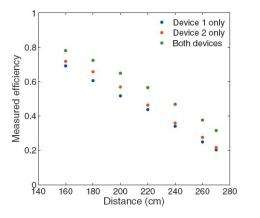February 12, 2010 feature
Coil in wall could wirelessly power multiple electronic devices

(PhysOrg.com) -- A team of MIT physicists has developed a system that can wirelessly transfer power to multiple electronic devices simultaneously with high efficiency. The system takes advantage of electromagnetic resonance coupling, and could be implemented by embedding a large copper coil in the wall or ceiling of a room. Somewhat surprisingly, the physicists found that the overall efficiency of powering multiple devices can be significantly higher than the efficiency of powering each device by itself, as long as the system is properly tuned.
Physicists André Kurs, Robert Moffatt, and Marin Soljačić of MIT have published their study on the new wireless power transfer approach in a recent issue of Applied Physics Letters.
As the scientists explained, the new wireless power transfer system could satisfy mid-range applications by filling the gap between short-range inductive systems (such as wireless power mats) and long-range radiative systems, which are sensitive to obstructions, require complex tracking mechanisms, and pose safety risks.
“The main goal of our research was to show that it is possible to transfer power between a source, which could be embedded in a wall, and receivers, which could potentially be embedded in actual devices, over distances comparable to the size of a room and with efficiencies that may be good enough for many real-life applications,” Kurs told PhysOrg.com.
To demonstrate their new system, the physicists built a large self-resonant copper coil that resonated at an optimal frequency of 6.5 MHz. The helix-shaped coil spans an area of about one square meter, and could be embedded in the walls or ceiling of a room. The large coil, which serves as the resonant source for two smaller coils, could wirelessly transmit power to electronic devices located a few meters away, although efficiency decreases with distance.
The system works on the principle of electromagnetic resonance, in which all devices are resonating at the same frequency. When this happens, the devices can transfer energy between themselves while interacting weakly with other off-resonant objects. The researchers also showed that the cross-coupling between electronic devices is about 15 times smaller than the coupling between each device and the source coil, which is necessary for efficient power transfer.
Experimentally, the scientists showed that the system could supply more than 25 watts of power to each of two electronic devices located two meters or more from the source coil. In addition, the researchers found that powering multiple devices simultaneously could increase the overall efficiency. For example, the system could achieve power efficiencies greater than 50% for multiple devices, whereas the power efficiency for a single device was less than 20%. Having multiple devices increases the coupling resonance, which leads to greater efficiency.
“Before it is widely used, we need to embed the receivers in a seamless way into devices,” Kurz said. “We would also like to make further improvements to the performance. Perhaps someday it will find its way into many consumer applications.”
More information: André Kurs, Robert Moffatt, and Marin Soljačić. “Simultaneous mid-range power transfer to multiple devices.” Applied Physics Letters 96, 044102 (2010). doi:10.1063/1.3284651
Copyright 2010 PhysOrg.com.
All rights reserved. This material may not be published, broadcast, rewritten or redistributed in whole or part without the express written permission of PhysOrg.com.


















